Do you know someone who just observed the pilgrimage of Hajj?
‘Hajj and the arts of the Pilgrimage’ by Qaisra Khan, is a visual celebration of the beauty and sacredness of the Hajj Pilgrimage through sumptuous images of maps, calligraphy, paintings, memorabilia and historical designs of the kiswa.
Hajj is one of the five pillars of Islam. The annual pilgrimage is undertaken by Muslims during Dhul-Hijjah, the last month of the Islamic Calendar. It is an obligatory pilgrimage every Muslim is inclined to perform at least once in their lifetime; if they can do so. The yearly pilgrimage involves a series of elaborate rituals that have remained unchanged since first established in the 7th century. Hajj is not only a physical pilgrimage but an artistic and spiritual connection to the Muslim faith.
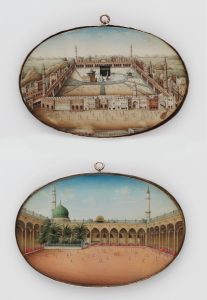
The Khalili Collection of art has played an important role in providing a comprehensive insight into the journey and understanding of Hajj. The ‘Hajj and Arts’ collection illustrates the religious, cultural and spiritual aspects of the journey through a unique and artistic lens.
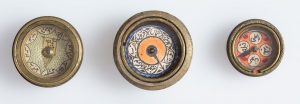
These three small qiblah compasses in brass cases are from 19th century Turkey and represent the direction of the qiblah in which Muslims align themselves for prayer. Compasses vary in size and design, often with painted details and a brass encasing.
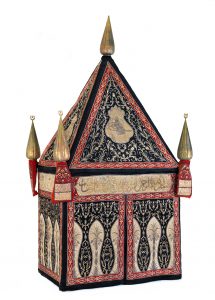
As well as a spiritual journey, Hajj encompasses a physical journey of strength and one that brings together various communities, including politics. Processions from countries including Turkey and Egypt sent Mahmals to symbolize the power of the Khadim al-Haramain (Custodian of the Two Holy Sanctuaries). The Mahmals had pyramid-shaped roofs, the body like that of a tent and were covered in amazingly detailed and embroidered textiles. This Mahmal was commissioned by Sultan ‘Abdulhamid II and ‘Abbas Hilmi II, the Khedive of Egypt.
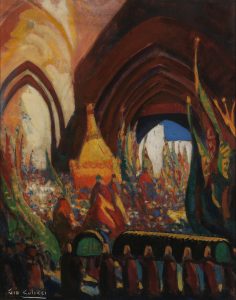
This 20th-century oil painting by Gio Colucci depicts the Procession of the Mahmal, an exciting celebration showing the commotion and crowd following the mahmal. The colourful send-off provides an insight into the love and excitement for the welcome and return of the pilgrims in time to perform the rites of Hajj,
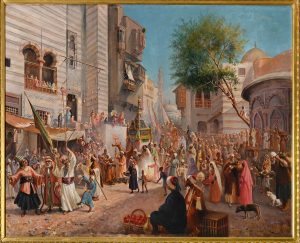
‘The Arrival of the Mahmal from Cairo’ by Leonardo de Mango also illustrates a Mahmal procession. Mango spent a lot of time in Cairo and was hugely mesmerised by the Middle East, inspiring this art piece and many more religious-influenced works. This artistic piece acts as a form of journalism, giving a visual insight into the cultural traditions around the Hajj. Families, neighbours, and friends would gather in the streets while the processions passed on camels and with flags and food.
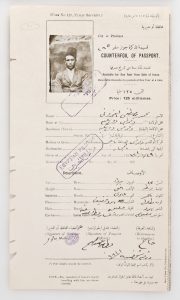
Like one would do to travel abroad, pilgrims would have needed to organise paperwork and passports and vaccine certificates. The left image shows details from a pilgrims’ passport, and the right a permit issued to Muslims travelling to Mecca. This (r) pilgrim has been given permission by Dutch authorities to perform Hajj and detailed specific, personal information such as height, weight, birthmarks, age and even facial characteristics. This is an example of the regulations and restrictions placed on pilgrims from Southeast Asia.
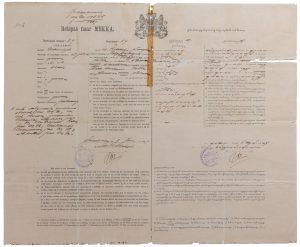
Camels, horses, and donkeys were not the only common modes of transportation. Sea and rail played a prominent role in transporting pilgrims to the holy cities, the Indian Ocean and the Red Sea being traversed by huge groups of pilgrims. Seafarers would travel through various landmarks and ports central to trade and pilgrimage and would face numerous challenges, including seasickness, weather and even pirates. This illustration depicts a group of pilgrims returning from Mecca after a disaster at the port of Tunis caused by the haste to depart. 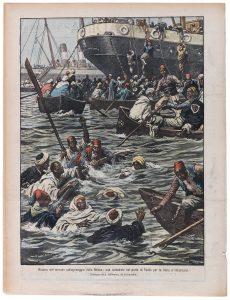
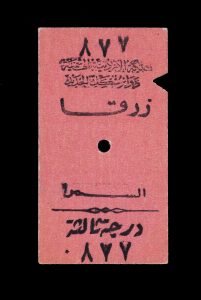
This 2nd class Hijaz railway ticket is a token souvenir of the journeys needed to take during the pilgrimage. Like sea travel, railways were important in transporting large groups of pilgrims and symbolising progression in the construction and engineering industry. The Hijaz railway was beneficial to the Islamic world and a social, political and religious endeavour that provided an incredible service to the Muslim community.
Journeys like the Hajj would have included various possessions needed for the journey and its ease. Decorated flasks like the one shown below were used by pilgrims to store Zamzam water, and this 18th-century gilded copper alloy flask is an example of this. The screw thread design of this vessel is designed to keep the Zamzam water void of any contamination and to minimize the risk of evaporation in the persisting heat. The spout and handle allow for easy pouring and the engraved decoration enhances its appearance, perhaps even being used during religious ceremonies.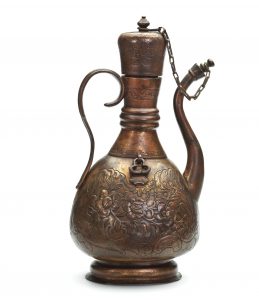
This photograph shows Artisans at work at the Dar al-Kiswah in Egypt in the 1940s. Hundreds of skilled craftsmen would have worked on the Kiswah of the Ka’abah, being responsible for a variety of crafts involved in the making, included spooling yarn, embroidering and weaving. Not only was the textile destined for the kiswah made here, but for mahmal’s and camels, which were looked after in a specific section. The workshops were full of craftsmen and artisans who taught apprentices who then went on to do the same. This rewarding craft is seen as an immense blessing.
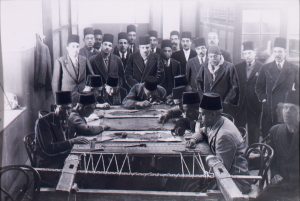
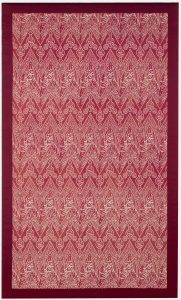 The textiles for the interior and exterior of the Ka’abah were very different. Below depicts a section from the internal kiswah of the Ka’abah. Possibly derived from India, this piece incorporates a general Ottoman pattern with variations to its inscriptions.
The textiles for the interior and exterior of the Ka’abah were very different. Below depicts a section from the internal kiswah of the Ka’abah. Possibly derived from India, this piece incorporates a general Ottoman pattern with variations to its inscriptions.
Depicted below is a photograph of a group of embroiders in Istanbul embroidering a curtain, the words ‘rasul’ visible.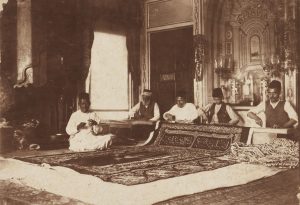
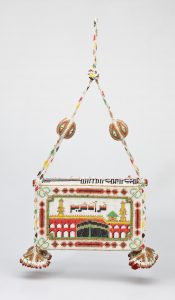 Lots of us can relate to friends or family going on pilgrimage and coming back with very distinct gifts and souvenirs. From glass-beaded bags to cameras with films of the Ka’abah and Masjid al-Nabawi, souvenirs are a beautiful way to commemorate the pilgrim’s spiritual expedition and show love to their families after returning from a long trip.
Lots of us can relate to friends or family going on pilgrimage and coming back with very distinct gifts and souvenirs. From glass-beaded bags to cameras with films of the Ka’abah and Masjid al-Nabawi, souvenirs are a beautiful way to commemorate the pilgrim’s spiritual expedition and show love to their families after returning from a long trip.
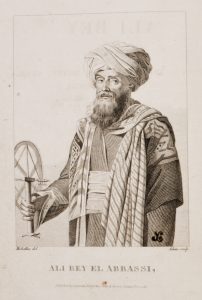
Many European visitors, chroniclers and journalists have had common misconceptions around Hajj, what constitutes the pilgrimage and what it means. This has led to multiple and various misinterpreted ideas and preconceptions that fall far from their reality. The Spanish explorer and chronicler Domingo Francisco Jorge Badia y Leblish, better known by Ali Bey El Abbassi provided geographical and scientific studies, allowing a more accurate case study of European interpretations. Although a lesser-known chronicler, we can owe it to individuals like himself that have provided a real insight into the annual pilgrimage and the Muslim world.
Blog Author : Saarah Ahmed
Author: Qaisrah Khan
Publishers: Assouline
Book Courtesy of Khalil Collection
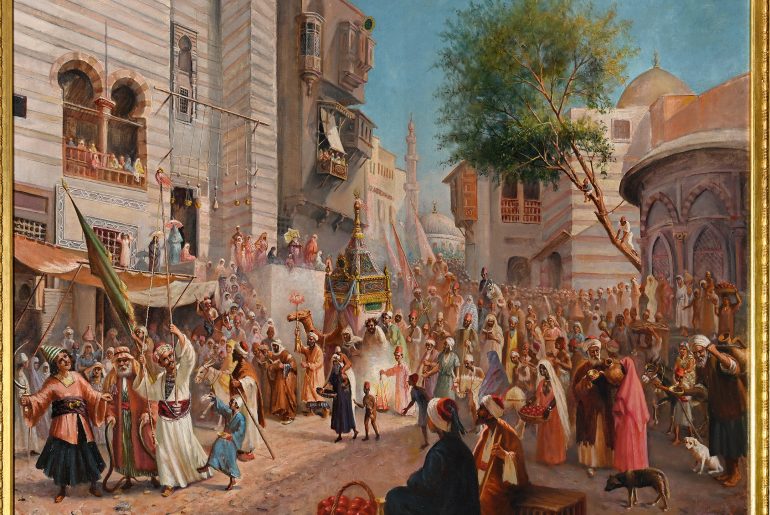
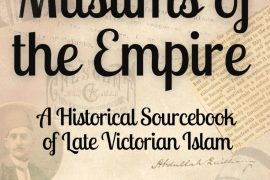
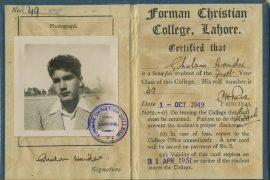
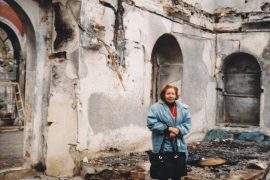
Comments are closed.